With the aim of informing, guiding and advising European car users about the true efficiency and use of the latest pure electric cars, the AUTOBEST international independent organization has performed end of May 2025 a new edition of its ECOBEST Challenge. 15 new EV’s from 15 different manufacturers were evaluated under true real life, real traffic, similar and reproductible conditions and went through 7 different kinds of tests, which results are of greatest interest for users of electric vehicles.
The most striking surprise of this year probably comes from Leapmotor T03, which delivers an incredible EcoC 1 index of 109.43% (EcoC 1 = ratio between real driving range and WLTP range)! This means that its real range is substantially higher than the official WLTP figure. This is unique in the ECOBEST Challenge history.
Our tests also revealed interesting improvements in terms of energy efficiency (EcoC 2 index = how many km of real driving range is provided by 1 kWh of battery). The absolute highlight is the excellent performance of DACIA Spring, which boasts a stunning 8.17 km/kwh, an all-time record for our proprietary index EcoC 2. It was closely followed by Leapmotor T03 with 8.06 km/ kWh. Another tested model managed to cover more than 7 km/kWh. Three cars above 7 km/kWh, this is another first. Just two years ago, we were reporting the fact that six cars out of 14 could cover more than 6 km/kWh, now it has become the norm: in 2025 only two out of 15 do not get there!
In general, electric mobility improves steadily, even if the 2025 ECOBEST Challenge does not show super-impressive leaps forward such as those seen last year in fast DC charging times. The 2025 tests also made obvious that progress is not very homogeneous: there is no absolute, undisputed EV champion. 5 different models from 5 different brands (Audi twice, Leapmotor twice, Kia, Dacia and Tesla) took victory out of the 7 categories of the ECOBEST Challenge’s tests and indexes.
By alphabetical order, here are the 15 cars the AUTOBEST jurors tested in the 2025 ECOBEST Challenge:Audi A6 Sportback e-tron Performance, BYD Dolphin Surf, Citroën ë-C3, DACIA Spring, Fiat Grande Panda, Ford Puma, Hyundai Inster, Kia EV3, Leapmotor T03, MINI Aceman, Opel/Vauxhall Frontera, Peugeot e-3008, Renault 5, Škoda Elroq, Tesla Model 3 LR.
“The 2025 edition of the ECOBEST Challenge has probably been the most interesting and relevant in our history: it is the first time that so many small and affordable EVs are available on our continent. We drove and tested all of them, and our results prove that it is now possible to buy EVs at affordable prices that offer long ranges and fast charging times. 2025 is probably just the beginning of new popular EVs coming on our continent markets.” said Dan Vardie, Founder and Chairman of AUTOBEST and creator of the ECOBEST Challenge.
“Even if the electric car is a revolution, its progress and refinement are more of an evolution: improvements are continuous and tireles but still made of small steps. Some may find it frustrating, but we should not forget that it took over a century to give automobiles the appearance and technology we know today. Compared to the last edition, the results of the 2025 ECOBEST Challenge show consistent improvements in all sectors. They are not really spectacular, however there is a fundamental change: the presence of several small-sized and affordable models among this year’s challengers. The EV world is becoming democratic. And this is key, because a true revolution cannot remain the prerogative of an élite. Another impressive highlight was the performance of one of these newcomers exceeding its official WLTP range by 10%” declared Alessio Viola, senior editor at Quattroruote and Vicepresident of the AUTOBEST Jury, in charge of the ECOBEST Challenge.
Based on the data provided by AUTOBEST, users can decide if they feel at ease with the switch from a traditional to an electric vehicle and/or evaluate if the one they would envisage to buy might fulfill their true needs. The unique, real-life testing methodology developed and refined by AUTOBEST has been certified by the independent Bureau Veritas organization.
Key figures, findings, interpretation and technical background in brief
- Do not always trust official figures! But for the time in many years, it has been for the better. ECOBEST’s EcoC1 test (ratio between real driving range and WLTP range) revealed a car with A REAL LIFE ELECTRIC RANGE SUPERIOR TO THE OFFICIALLY ANNOUNCED WLTP FIGURE: Leapmotor T03 managed to obtain a 109.43% index, covering up to 290 km while the WLTP range is of 265 km!
- Our EcoC 1 tests show that ALL MANUFACTURERS’ PUBLISHED RANGES GET CLOSER TO REAL LIFE. Out of the 15 electric cars tested at the 2025 ECOBEST Challenge:1 car has a longer range than announced (Leapmotor T03)5 cars feature a real-life range that is comprised between 90 % and 97.3% of the official figure 7 cars are between 80% and 89.8 %. Only 2 cars managed an EcoC1 index below 80%.
At this year’s edition there is no car below 77.5% – a clear improvement from last year low of 73%.
- SIGNIFICANT IMPROVEMENTS ON ENERGY EFFICIENCY AND A NEW ALL-TIME RECORD! In the ECOBEST Challenge, the EcoC 2 index is the most important expression of the energy efficiency of an EV: it reveals how many kilometers of real driving a specific car can provide from 1 kWh of battery. And here, DACIA Spring set a new EcoC 2 record with an excellent 8.17 km/kWh, beating itself as the previous record holder: Spring in 2021 had established it at 8.07 km/kWh. This figure was closely approached in 2025 with the second-best performer, Leapmotor T 03 (8.06 km/kWh). In 2025, 3 of the 15 tested cars covered more than 7 km/kWh. Last year, none of them did.In 2025, 13 of the 15 tested cars were above 6 km/kWh. Last year, there only were 8 out of 13. In 2025, only 2 cars were below 6 km/kWh, and both were close (5.86 km/kWh). In 2024, 5 out of 13 were below 6 km/kWh, one of which even at only 4.5 km/kWh.
- DISCLOSED: THE REAL EFFICIENCY OF THE CHARGING PROCESS (EcoC 3 test = ratio between real energy charged into the battery and the official net capacity): some energy is “wasted” when you charge the battery of an EV, and AUTOBEST uses the EcoC 3 index as the clear expression of the charging process’ efficiency. This year Audi A6 Sportback e-tron is the best, with a very low difference of 5.9% between the real energy charged into the battery (the energy you pay for when charging the battery) and the battery’s official net capacity (the energy you can use for driving).11 out of the 15 tested cars feature a ratio comprised between 10 and 20%; due to rather frugal technology the Dacia Spring gets even higher (21.3%).
- AN EV’S REAL ENERGY EFFICIENCY SHALL BE MEASURED WITH THE COMBINATION OF ITS DRIVING EFFICIENCY + ITS CHARGING EFFICIENCY (EcoC 4 index = how many km of real driving a car can provide from 1 kWh coming from the charger): The EcoC 4 index was introduced two years ago to give an even better real-life perspective. It measures the car’s actual efficiency taking into consideration the energy filled into the battery (and not the net battery capacity) AND the real range.
- The best performing car in the index, so the best in term of real-life efficiency is Leapmotor T03 with 6.89 km covered with each charged kWh.
- REMARKABLE IMPROVEMENT IN DC FAST CHARGING: This year also, a new record was set in DC fast charging (EcoC 7: time required to fill up 100 km of range using a 350 kW Hpc charger – charge from 20% to 80): the Audi A6 Sportback e-tron managed to charge enough electricity in its battery to cover 100 km in just 6 minutes. It is 1 minute less than last year’s record from KIA EV9 (7 min). Excepting the very small EVs, all tested cars managed to get 100 km in less than 18 min of DC fast charging.
The overall performance of all the cars in this key parameter clearly shows that we are fast approaching peace of mind for the charging process.
- THE TRUTH ABOUT EVs’ FAST-CHARGING CAPABILITY. As a first, AUTOBEST also publishes this year (together with the EcoC 7 index) the average peak in the DC fast charging process to reveal how far or close is the real charging process from the officially published capability. BYD Dolphin Surf, DACIA Spring and Mini Aceman E all three surprises with real peak values that are superior to those officially published (BYD with 86 kW vs 85 announced; Dacia with 33 kW vs 30 official; Mini even with 78 kW vs 70 official).All other models revealed a lower real peak of DC charging than officially published.
- NO GREAT ENTHUSIASM FROM AC CHARGING RESULTS! (EcoC 6 index = time required to fill up 100 km of range using a 22 kW AC charger – charged from 0 to 100%). AC charging capabilities of most tested cars remain quite modest, requiring rather long time for charging. 12 out of the 15 tested cars have 11 kWh AC charging capability, 3 are closer to 6.5-7.5 kWh.
- Tesla leads the pack with 1h 31min required to charge the energy allowing it to cover 100 km – the worst performing car also equipped with 11 kWh capability need 30 minutes more!
- BETTER CHARGE BEFORE THE BATTERY TELLS YOU IT’S EMPTY! (EcoC 5 index = range after zero km / 0% on the cluster till final stop of the car). The ECOBEST Challenge pioneered this index from its beginning in order to check how much life there still is in the battery after the cluster indicator tells it’s empty (zero km range or 0% energy left).
- All tested cars demonstrated a strategic reserve of electricity allowing to drive for 3 km minimum (BYD Dolphin) and a maximum of up to 36 km (Kia EV3).
- The average distance that can be covered after the battery is announced to be empty is of 10-12 km… but it’s wiser to recharge before testing!
- This year’s winner remains far from the 45 km record measured in 2023 (Subaru Solterra 4E-perience).
- ECOBEST PROVIDES RELIABLE TESTS THANKS TO A CERTIFIED METHODOLOGY: The 2025 edition of the ECOBEST Challenge received for the third consecutive time the Bureau Veritas certification – a global recognition of the genuine, comprehensive, and innovative methodology employed in testing electric vehicles (EVs) in real traffic conditions and assessing their real-life green credentials in an unbiased manner.
- A DEDICATED, EXCLUSIVE APP COLLECTS ALL DATA: For the fourth year, the ECOBEST Challenge is using an app specially designed to measure the key data through a direct connection to a Motorola mobile terminal in the car. With this, AUTOBEST is harnessing a wide range of data & graphs from the testing sessions and the charging process with both AC and DC (HPC). We also record the batteries’ temperatures during different stages of the test and charging. These data are available on request.
- PRECIOUS TECHNICAL PARTNERS SUPPORT THE ECOBEST CHALLENGE: To perform all tests, AUTOBEST could count on the logistical and technical support of the Italian car publication Quattroruotethe support of Motorola for mobile devices,E-GAP’s expertise and material to offer remote charging once the batteries were depleted at the end of the test. The app to measure the cars’ data is PKC – Power Check Control, developed by the Italian company Power Cruise Control.
Preliminary considerations on the ECOBEST Challenge
The ‘ECOBEST Challenge 2025, supported by Quattroruote, is the first and the only certified European independent real traffic test of mainstream EVs designed to reveal their real green credentials. It remains the only test of this kind with a transparent, neutral, and balanced approach. The results come from a consistent methodology of testing performed identically on all 15 cars. This methodology is inspired by the practical needs and driving behaviors of most European motorists, coming from the habits in their daily commuting.
CRITERIA OF SELECTION FOR THE 15 TESTED CARS
Only the new, popular EV’s –below 65.000 Euro, standard entry level price, with no tax and no incentives – on the European markets are selected. The detailed specs of each tested car is in the annex together with all measurement data.
The ECOBEST Challenge is not designed pro or against any model or brand. It is neither a typical motoring media comparative test nor a record-breaking range test or – by contrast – a rally speed test to check how agile EVs are. The ECOBEST Challenge publishes the results of the measurements collected during the tests and a ranking based on its own proprietary indexes and measurements.
The test results are available to European car users as a basis for their decision-making process.
The 2025 edition received for the third time the Bureau Veritas certification – a global recognition of the genuine, comprehensive, consistent, and innovative methodology employed in testing electric vehicles (EVs) in real traffic conditions and assessing their real-life green credentials in an unbiased manner.
ECOBEST Challenge is a project of AUTOBEST. It was created by Dan Vardie, the Founder & Chairman of the AUTOBEST organization.
Major findings
As a consequence of this unbiased approach, the real range results show that WLTP – compared with last year’s measurements – is becoming a bit more realistic and closer to driving in real traffic. With one of the tested models establishing a record for EcoC 1 and all the others been better than last year, it looks that the official driving test is becoming more realistic, to the benefit of car users’ information.
Introduced four years ago, AUTOBEST key index named EcoC 2 represents the quintessential idea of EV energy efficiency. In this reduced time frame, EcoC 2 already achieved an important recognition among EV consumers and the industry. It is simply how many kilometers of actual range one kWh of the battery can offer for a specific model.
“At this edition we establish a new record for EcoC 2, probably the most important criteria now and in the future: energy efficiency! DACIA Spring and Leapmotor T03 are the only EVs able to drive more than 8 km with 1 kWh of battery. But we also testimonies one additional car with more than 7 km/1 kWh of battery – Mini Acemen E. This is not only better compared with last year, but it also makes these three EVs very efficient cars in our competition history.
AUTOBEST was the first independent organization who emphasized the paramount importance of energy efficiency on board of cars. We also stated that achieving 10km/kWh is crucially important for our industry. But the results of this yea’sr EcoC 2 index show that the industry’s progress in energy efficiency is very slow. To be competitive, EVs should grow dramatically on the energy efficiency, and this is a key imperative for all the EV makers around the globe. ` stated Dan Vardie.
The lowest EcoC 2 index at the test was 5.86 km/ kWh, in clear progress from the lowest EcoC 2 indexes from the previous year (4,52 km/ kWh).
The ECOBEST Challenge is one of the only independent tests in Europe measuring what happens after the battery reserve indicator/ available km reaches zero. All the cars have been driven to a total depletion of the battery and a final stop. AUTOBEST is happy to deliver good news to all motorists: except for one car: there is still life in the battery once it indicates zero on the cluster. All cars proved between 3 and 36 kilometers of driving remained. Best in this criterion in the Challenge has been the KIA EV3.
This year no car ‘died’ immediately after the battery cluster indicated zero. Compared with last years, this edition test shows a less diverse range with smaller figures, indicating an imperative need for consumers to inform themselves on this key information.
Although it is very important to know how `much life you still have in your apparently empty battery`, AUTOBEST recommends keeping this as a strategic reserve of the battery and better never entering the situation to use it.
Another interesting result of the ECOBEST Challenge is the energy needed to fully charge cars with totally depleted batteries- index EcoC 3. All the vehicles required more energy than the capacity of the batteries – between 5.9% and 21.3%. The best in this criterion is Audi A 6 Sportback e-tron which is keeping the maximum of energy received from the charger.
The additional consumption when recharging has been investigated and it has several causes.
Some energy is lost when transformed from AC (grid) to DC (battery).
Some energy powers all the car systems used for charging, mainly the inverter but also the software, the socket, and everything related to the process.
Energy is also used to cool the battery during the process; this energy increases with fast charging, especially under hot climatic conditions.
The state of the batteries and the charger type may also generate some losses.
In our continuous improvement, AUTOBEST has added last year the EcoC 4 index, a key parameter for evaluating the true efficiency of electric cars. It measures how many kilometers the car runs on a single kWh considering not the nominal net capacity of the battery, but the total amount of energy supplied by the charger to fill it. Above all the explanations we mentioned, the driver pays for energy, and these supplementary kWh ‘are ‘escaping’ the trip computer. The best EcoC 4 index is achieved by Leapmotor T 03, and the value is 6.89 km/ real kWh charged. Because of the energy loss when charging, the n°1 in EcoC 2, DACIA Spring is coming as n°2 in the rankings of EcoC 4. The value of Spring – 6,73 km/real kWh charged – is still very competitive and close to n°1.
We measured the AC and DC Fast Charging processes with great accuracy using 22 kW AC stations and 350 kW DC stations, which delivered the maximum charging capacity to all the cars in test. We also measured the time needed for the charging process.
Two years ago, we registered the record of just 4 min for Hyundai Ioniq 6. In our 2025 edition, the 6 min required by Audi A6 Sportback e-tron are better than the 7 min of last year’s champion, KIA EV9. But it is also important to highlight the fact that last year the longest time for fast charging 100 km was 18 minutes, vs 32 min in 2025. Each car’s maximum charging capacity determines this time. And as we noticed: the smaller the car, the smaller charging capacity it has.
Two important notes:
- With AC, we charged the batteries from 0 to 100%
- With DC, the charging process was comprised between 20% and 80%, the most commonly recommended cycle for such charging.
The time required for charging 100 kilometers is an average of the entire charging process and has to be understood as such. As we noticed, charging rates are not linear during the DC fast charging. AUTOBEST has all the charging graphs, which are a part of the data available on request.
`Although this year two models manage to win two of our seven rankings each, ECOBEST Challenge is proving again that there is no single car able to win in all the rankings. It is the challenge of the industry to perform better in several key areas monitored by our AUTOBEST comprehensive Challenge. It is also key for EV users to learn which of the key measurements we perform are the most important for them. At AUTOBEST we monitor closely these observations and try to adapt our results of ECOBEST Challenge. ` declared Dan Vardie
To get precise and complete data in the 2025 ECOBEST Challenge, AUTOBEST operated in close cooperation with Quattroruote and its Centro Prove, using Power checK Control (PKC) to analyze and certify all electric cars. Since it is connected in real-time with the car via a Bluetooth Onboard Diagnostic II (OBDII) dongle, PKC accesses many parameters of the actual battery status: the SoC (State of Charge), the SoH (State of Health), the temperature, the car’s speed, weather conditions, the power used or regenerated by the car, the power during the charging phase and other relevant factors. EV drivers may get this expertise in daily life using Power Cruise Control: PCC suggests the right charging points along the route and precisely calculates how many kWh you need to charge. And to use it in the best way, this software gives constant feedback to the driver via an intuitive interface called the Heaven-Hell indicator.
Please see the Annex tables with all the relevant data to discover all results.
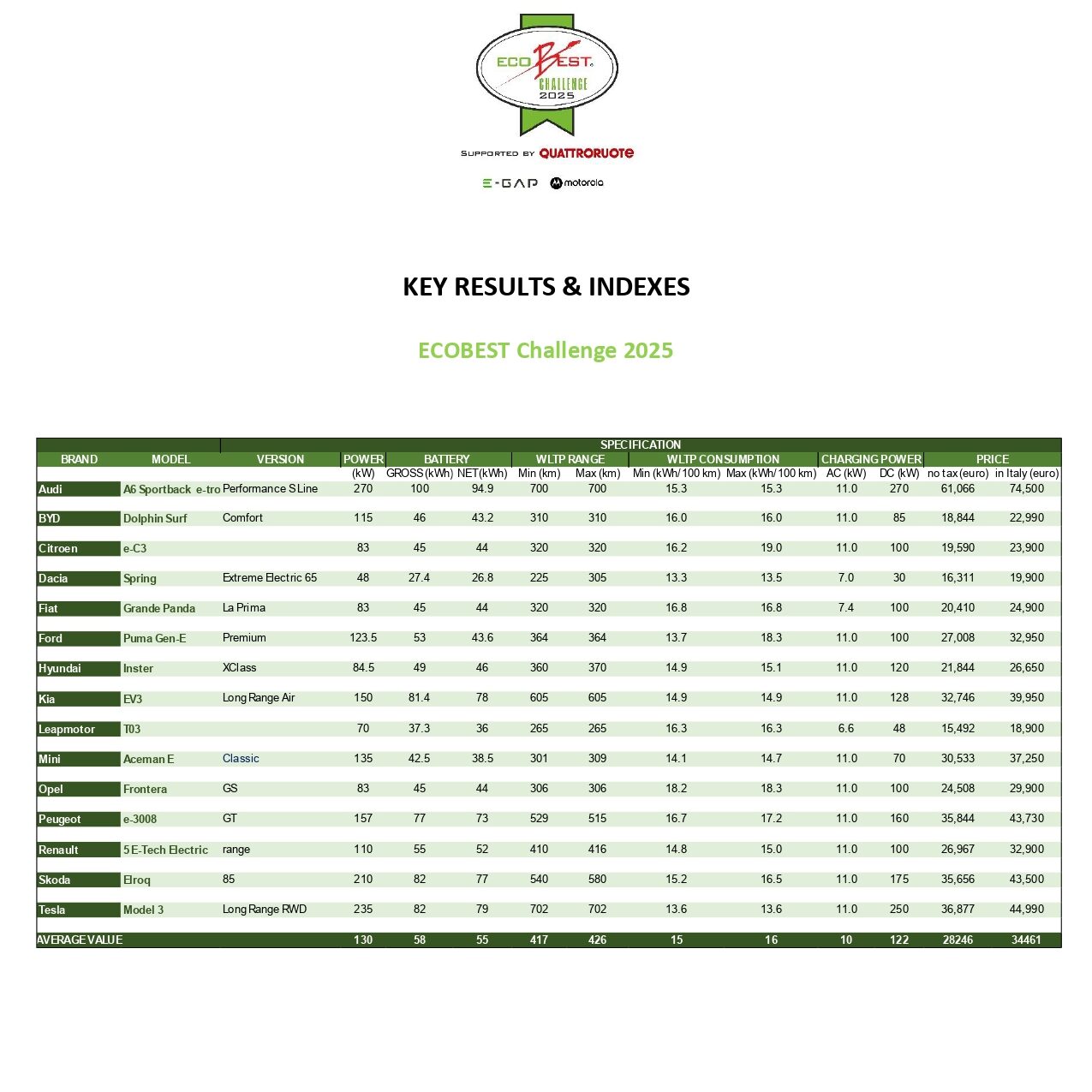
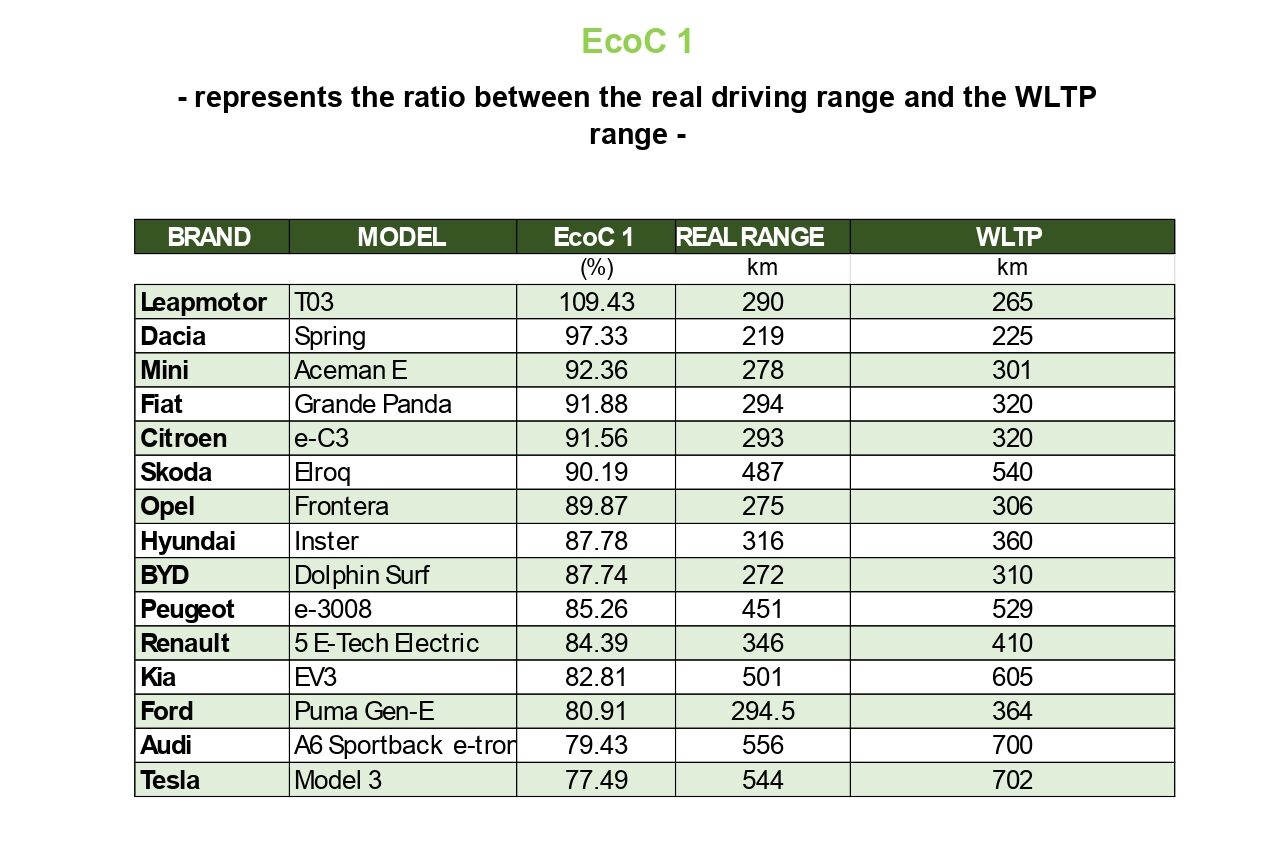
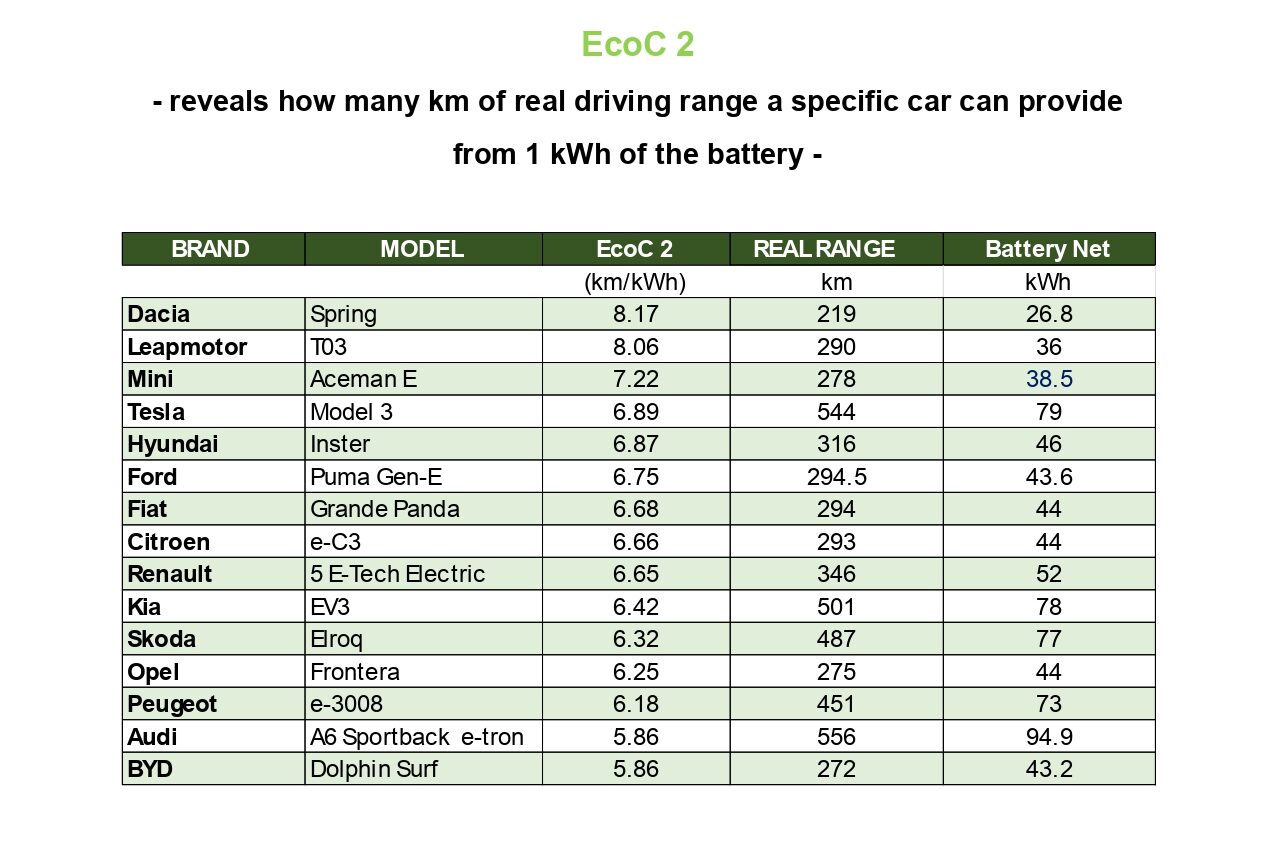
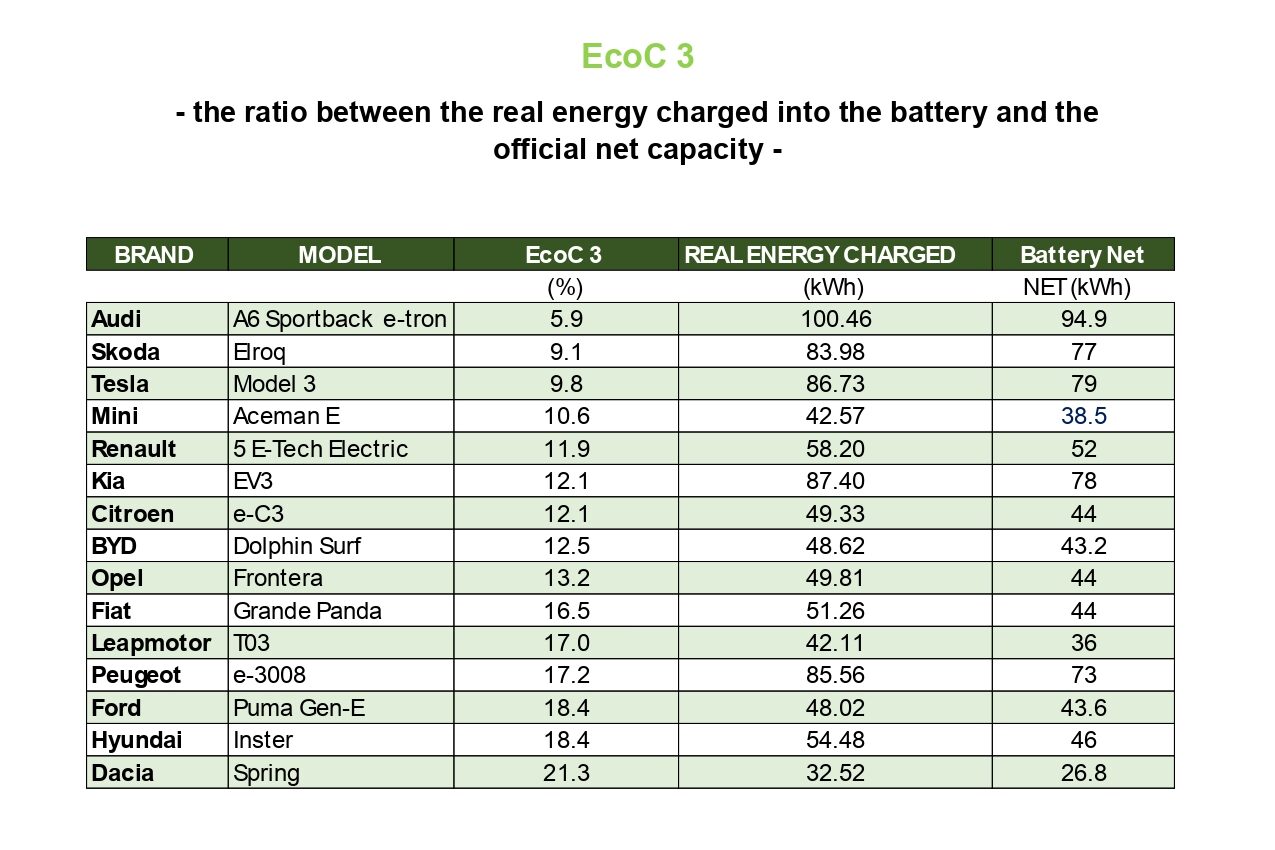
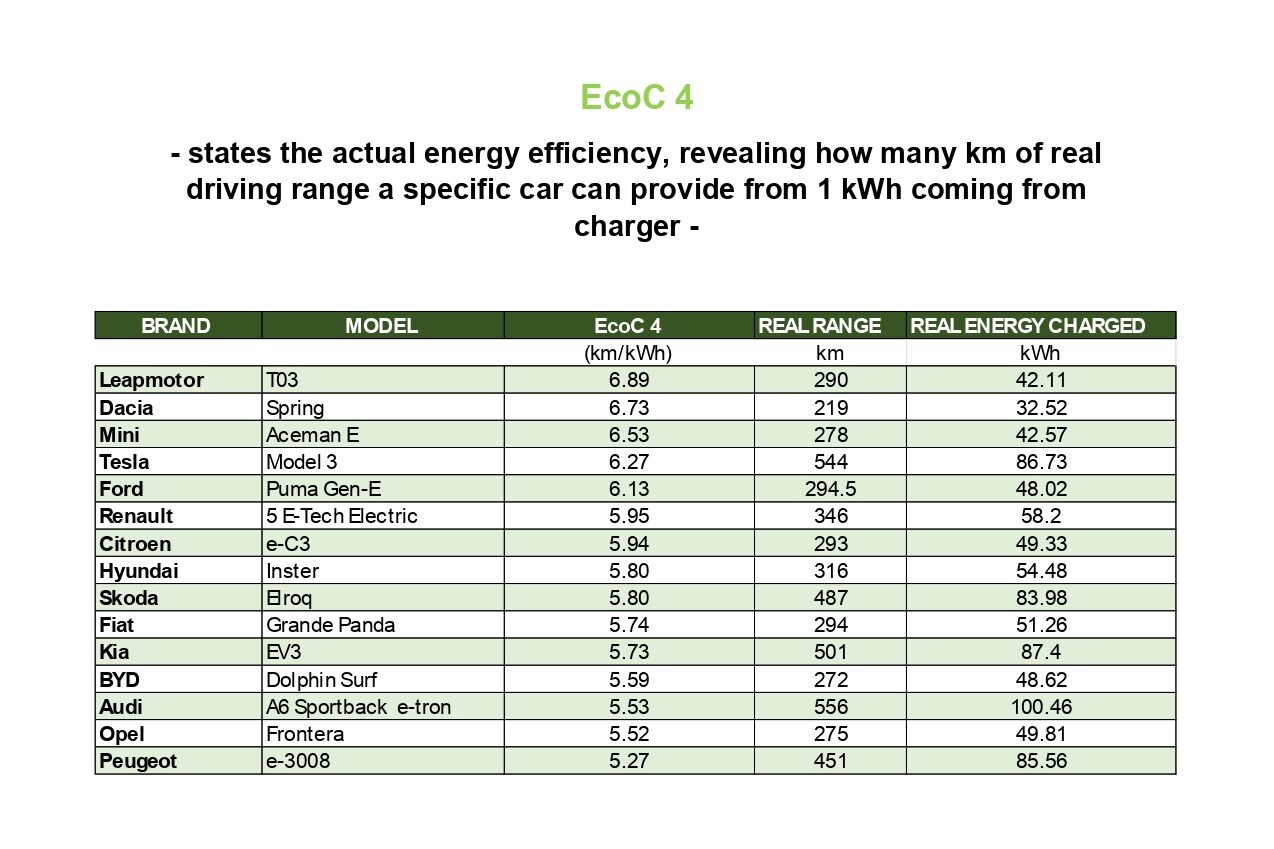
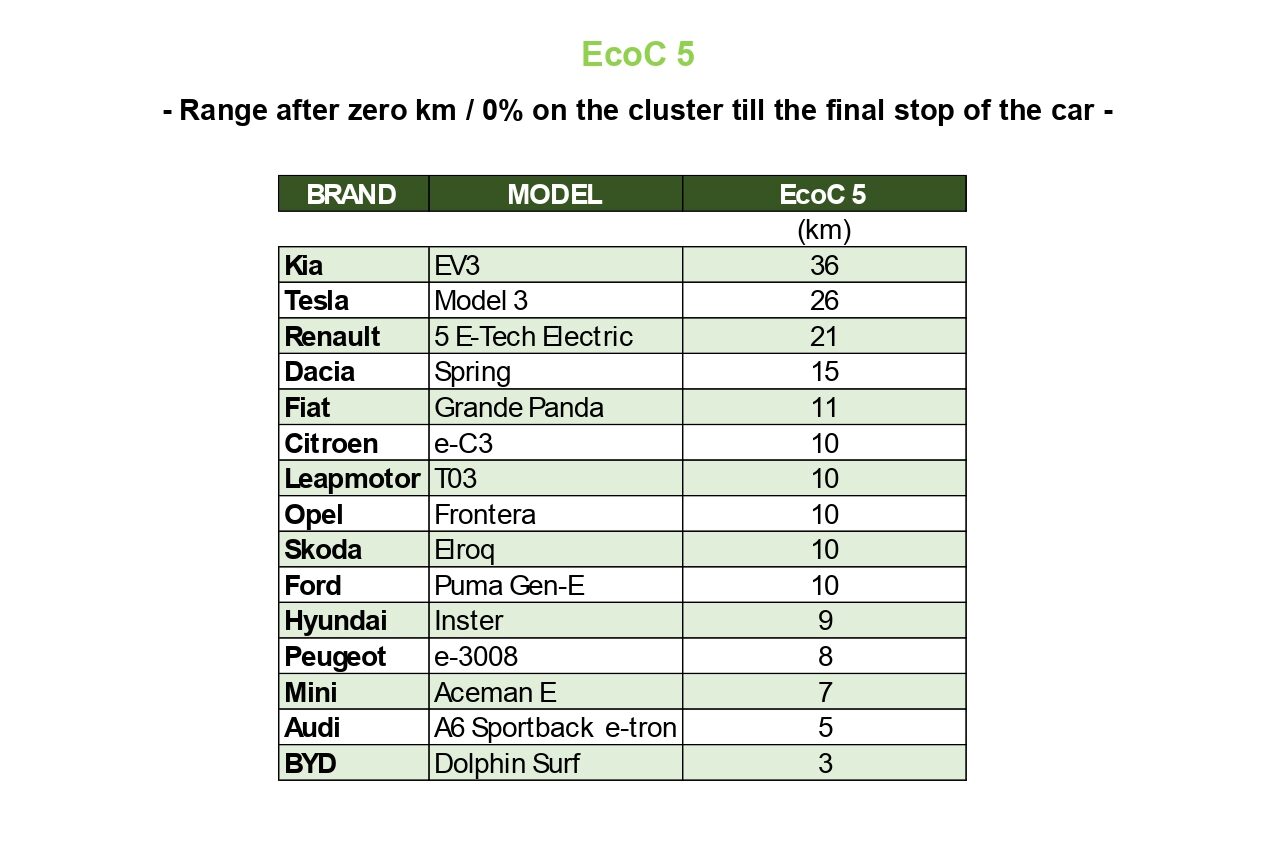
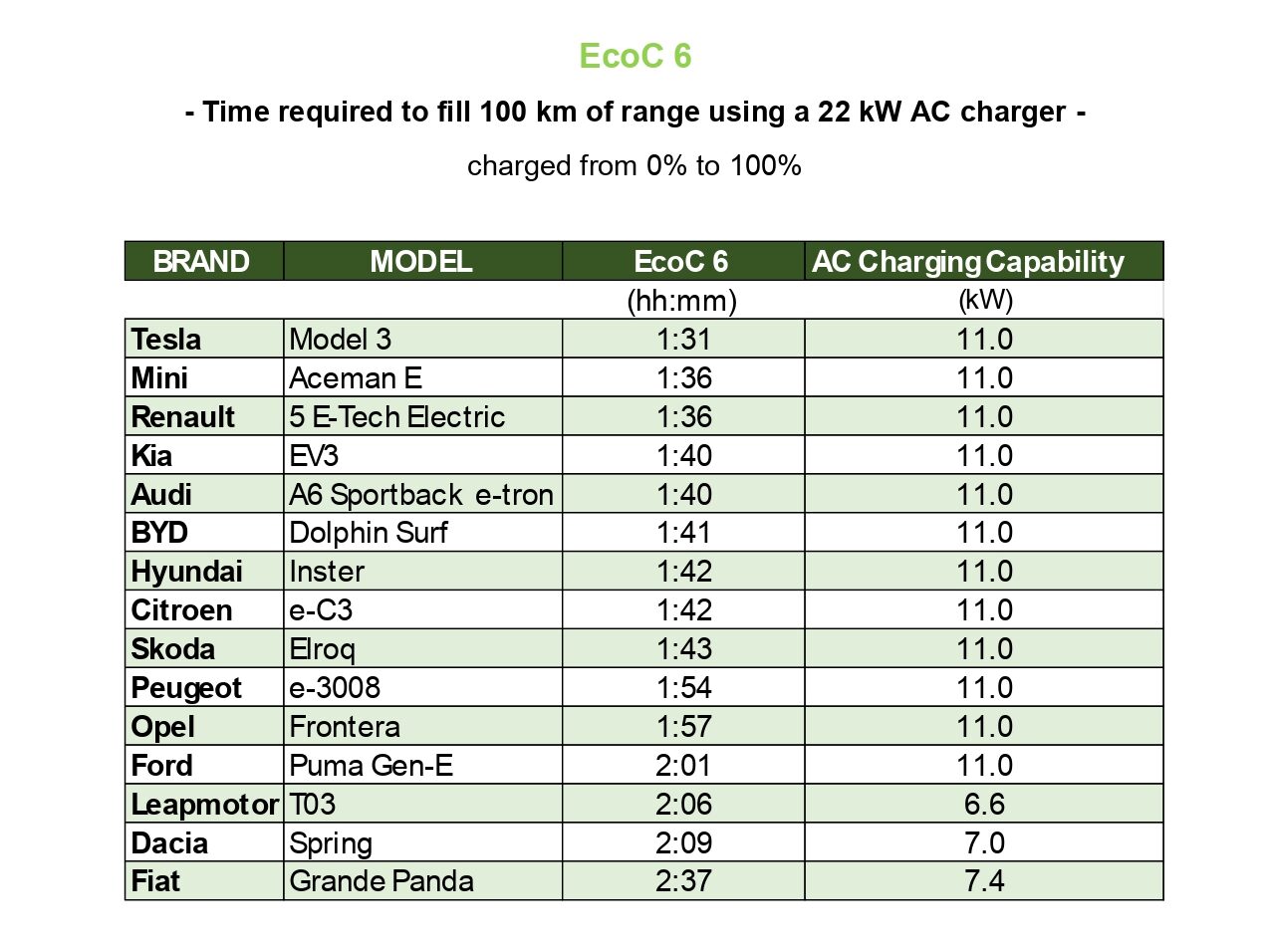
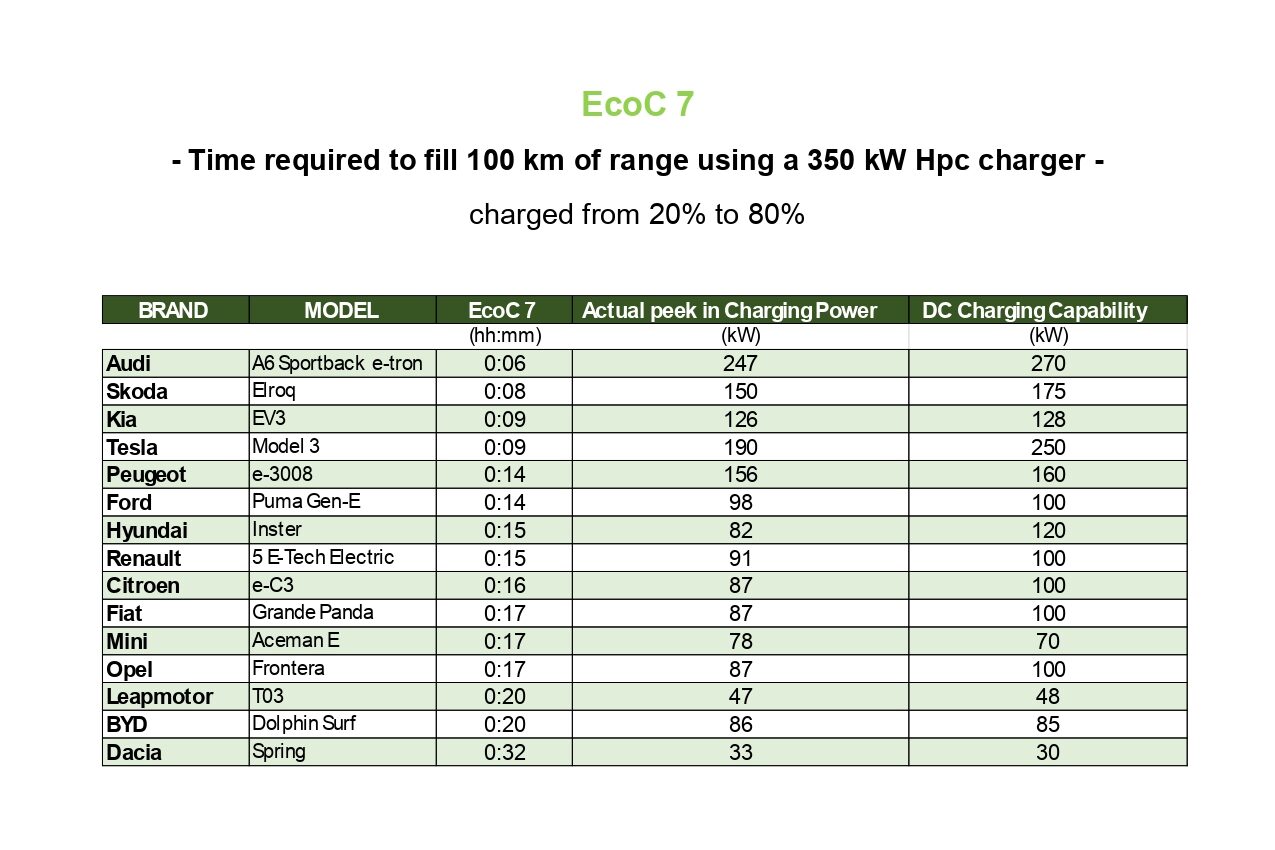
SOURCE: ECOBEST Challenge
